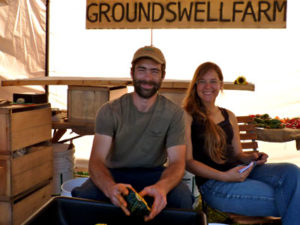 |
| Mike Bowman and Maria Reynolds of Groundswell Farm at their booth at the Common Ground Country Fair. English photo. |
By Holli Cederholm
Mike Bowman and Maria Reynolds named their Groundswell Farm after their farming ideology and the topography of the 7 acres they are leasing in Solon, Maine. Their 4 acres of MOFGA certified organic seed and market vegetable crops and 3 acres in cover crops crest in small hills, lending the landscape, in Reynolds’ words, likeness to the swelling sea. The name also harkens to the groundswell of general interest around sustainable organic agriculture, including seed production.
Bowman and Reynolds founded their farm business in 2010 after years of varied agricultural experiences. Bowman is the sixth generation to live on the family orchard in Cornville. Bowman and Reynolds both apprenticed on MOFGA certified organic farms before attending college together at the University of Maine. While there they worked at and then co-managed the Black Bear Food Guild, a student-run organic vegetable CSA and market farm. After graduation they pursued work at other farms and at Johnny’s Selected Seeds, where Bowman worked at the research farm in Albion and Reynolds worked in the sales department in Winslow.
The two have always been interested in seed, but credit their transition to seed production to working at Johnny’s.
“Something happened at Johnny’s,” says Bowman. “At their research farm they do a lot of trialing of new varieties, of grow-outs and seed production.”
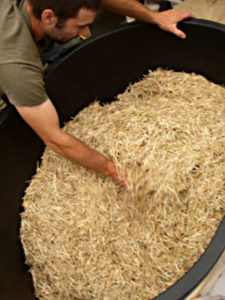 |
| ‘Red Russian’ kale is overwintered under row cover on Groundswell Farm in Solon. The seed is harvested the second year and threshed by hand. Photo courtesy of Groundswell Farm. |
Bowman especially enjoyed working with the trials of pumpkins and tomatoes. “Everything about it was pretty fascinating,” he says.
Reynolds acknowledges that while neither had explicit experience in producing organic seeds on a farm scale, both had plenty of experience growing vegetables. She says, “It [seed production] is tricky and it’s hard but it’s doable. There’s a strong need for it, for seeds that are adapted to this area.”
Seeding Their First Season
In 2009 they broke ground in Solon while maintaining off-farm jobs. The acreage had not been in agricultural production for some time; its maintenance then consisted of regular bush hogging, which created fields of “bonsai cherry trees.” Bowman and Reynolds couldn’t even get a plow through the dense network of roots, so they opted for an aggressive system of disc harrowing.
“You can bring land back,” says Bowman.
After an initial soil test, they developed a long-term management plan including rotating their heritage breed pigs (Large Black-Hampshire and Large Black-Tamworth crosses) with cover crops and green manures to boost fertility.
That first year they limed, spread manure and planted cover crops. The following season, Groundswell Farm raised its first seed crops – 1/4 acre of garlic and 1/2 acre of sunflowers.
“It’s beautiful to see a big field of sunflowers,” says Reynolds.
Bowman started working full-time on the farm in 2011, while Reynolds continues to work as Crown O’ Maine Organic Cooperative’s sales, outreach and development coordinator.
They planted 4 acres in crops, with a quarter of their overall production designated to fresh produce marketed at the Farmington Farmers’ Market and wholesaled to a handful of local accounts.
“We decided to really diversify,” says Bowman. They considered crops with high seed yields, and, says Bowman, “We planted more of the crops I was familiar growing seed with at Johnny’s.”
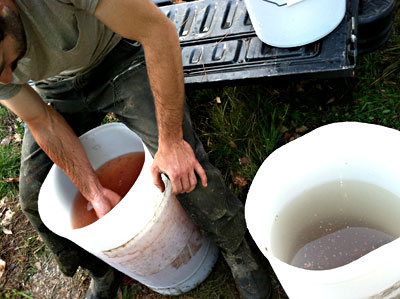 |
| Tomatoes are hand-crushed, mixed with water, and fermented to separate fruit from seed. After a fermentation period, water and the floating nonviable seeds are poured off, leaving behind the viable seeds that sank to the bottom of the container. After being dried, clumps of tomato seed are separated by hand. Photos courtesy of Groundswell Farm. |
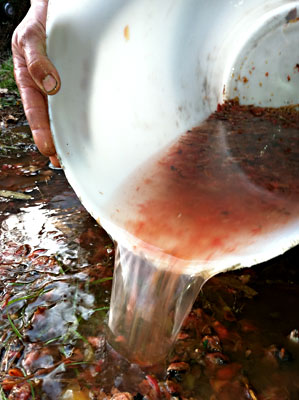 |
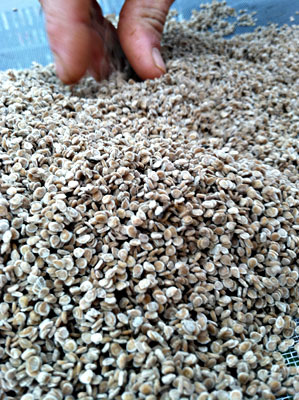 |
The additional crop list includes winter squash, kale, tomatoes, peas, hot and sweet peppers, calendula, and dry and snap beans, among others.
Seed Production Basics
While Groundswell does grow seed crops, not much differentiates the farm visually from an organic market vegetable farm. Bowman and Reynolds start all their seedlings in a wood-heated, home-built, 16- by 32-foot greenhouse and, for the most part, transplant crops into beds similarly suited for market vegetables at times when market crops would be planted. Black plastic mulch fosters a warmer microclimate for heat-loving members of the Solanaceae and Cucurbitaceae families; cover crops and green manures grow among their production crops.
But the vegetable farm and the vegetable seed farm do have differences. Timing is a big one.
For certain crops, such as tomatoes, seed is mature when the fruit is ripe and ready to eat. Others, such as cucumbers, must ripen longer to produce viable seed. A market farmer picks filet beans when they are young, tender and crisp; a seed producer maintains snap bean plants long past stir-fry stage, allowing the seeds to swell and the pods to dry.
“There are different things that have to be considered… like pollen drift from a weed in the same family as the crop you’re trying to save seeds from,” says Bowman.
Isolation, to maintain genetic purity, is a crucial consideration for the seed producer. Bowman and Reynolds use row covers to warm crops and protect them from pests, but also as a buffer for certain crops, such as peppers, from pollen contamination between varieties. They cover plants immediately after transplanting, burying the edges, and remove covers after flowers have dropped.
Lacking sufficient space to adequately isolate crops and lacking the workforce to pollinate by hand and bag flowers, Bowman and Reynolds isolate some crops by time. When selecting winter squash seed crops, they cultivate only one variety from each of three species (maxima, moschata and pepo) per season. Similarly, they plant and harvest seed from only a single type of sunflower annually.
Starting at seedling emergence, they monitor crops for vigor and trueness to type, rouging any deviants. “We do a good scout routine,” says Reynolds. Diseased plants, should they arise, are removed immediately.
“We’re really careful during the whole process,” says Reynolds. With wet-seeded crops such as tomatoes, peppers and squash, they harvest only ideal fruit.
Harvest to Market
All seed crops are harvested and cleaned by hand with straightforward technology. For instance, kale and bean seed pods dry in the field and are then harvested and threshed by hand. These crops are winnowed by pouring quart cups of seed in front of a box fan; the chaff blows off and clean seed drops into a container below.
Peppers and squash are halved and seeds are removed by hand and then spread on homemade screens positioned on tables in a shaded (tarp-covered) greenhouse to dry.
Tomato seeds receive the same treatment after they are fermented, in which ripe tomato seeds are squeezed into 55-gallon plastic drums and mixed with water. After a few days the water and floating non-viable seeds (collectively referred to as “tomato mash”) are poured off the viable seeds. The tomato mash, as well as other vegetable residue, is fed to their pigs.
When all seeds are dry, they are stored in a temperature- and moisture-regulated room. Germination testing, to ensure all their crops meet or surpass federal standards, occurs before sales. Lots of 100 seeds are placed in a moist paper towel within a plastic bag. “It’s all very low-tech,” says Reynolds.
Bowman and Reynolds market their seeds through wholesale and retail strategies. In 2011 they grew several crops, including ‘Jimmy Nardello’ sweet peppers, on contract with Fedco in Clinton. They hope to pick up more wholesale accounts in the future.
“We’re working on building our name as a seed farm,” says Reynolds. She would like to see Groundswell transition entirely to seed production with a farmer-owned seed company at the heart of the operation. They have a preliminary website (www.groundswellfarm.wordpress.com) and are working on offering a catalog showcasing seed they grow. Bowman notes that their selection can grow annually. “As long as seed is up to germination and stored right, our offerings each year will increase,” he says.
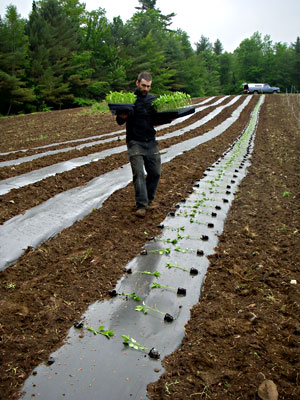 |
| Mike Bowman transplants a seed crop of ‘Jimmy Nardello’ sweet peppers into black plastic mulch. Transplants will be covered with AG-19 floating row cover to prevent cross pollination. Photo courtesy of Groundswell Farm. |
“Eventually someone who opens up our catalog can grow a nice full garden,” Reynolds says.
“Season extension for seed will become really valuable,” adds Reynolds. To round out their catalog with biennial crops such as carrots and kale, which need to be overwintered before they’ll flower and set seed, they are investigating methods familiar to winter greens growers. “Instead of digging up all our carrots, we could overwinter them in a high tunnel with a couple of layers of plastic, and they’re already isolated.”
Groundswell sold its seed in packet sizes appropriate to the home gardener at last year’s Common Ground Fair and looks forward to offering seed, and seedlings grown from its seed, early in the farmers’ market season.
An Organic Ethos
Certifying Groundswell Farm’s seed crops was a given. Bowman had his first organic vegetable garden in 1994 at the age of 15, and he’s never considered producing food without using organic methods. “I’ve always been growing organic,” he says.
Bowman explains that seed crops don’t have the same regulations as food crops, which means that conventional growers can apply even more synthetic pesticides. “There’s a dead zone off the coast of Oregon from agriculture in the valley,” he says. “To offer organic seed, you’re allowing people to make the decision to choose an environmentally responsible product.”
Reynolds adds that locally grown organic seeds are a real need in today’s agricultural system; most seed used in the United States is not organically grown, and much of what is organic has been imported.
“Seed is another part of the local food movement; we need to focus that back just like we need to bring local food back,” says Reynolds. “I don’t want watermelons from China, I don’t want watermelon seed from China either.”
What Reynolds and Bowman do want is to increase the availability of locally adapted rare and heirloom varieties – through their own production and by sharing what they’ve learned with others.
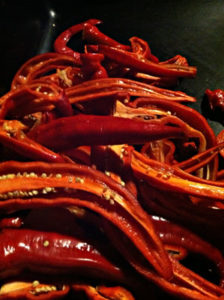 |
| ‘Jimmy Nardello’ and other pepper seeds are collected by hand after the fruits are cut in half. Wet pepper seeds are spread on homemade screens in a shaded greenhouse to air dry before storage. Photo courtesy of Groundswell Farm. |
Bowman says, “There are not a lot of resources out there, especially for small growers on the East Coast… We want to inspire people to save seeds.”
Reynolds remembers that saving seed was commonplace, rather than a subject that young farmers like themselves referenced in Suzanne Ashworth’s book Seed to Seed. “My grandfather from Italy had the best tomato ever and he always saved his seed. It was his tomato from the old country.”
Reynolds says, “Seed is not just a one-year affair. Yeah, it’s the next year but …”
“It’s the next generation,” finishes Bowman.
About the author: Holli Cederholm was MOFGA’s farmer in residence, with Brian St. Laurent. Their Proud Peasant Farm is now located in Washington, Maine.
